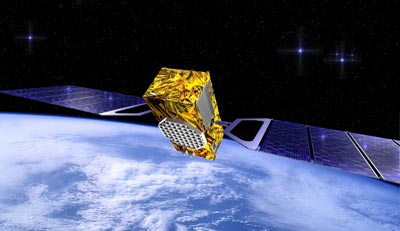EU-US chronowarby Taylor Dinerman
|
| A hydrogen maser costs only about $250,000 more than a cesium clock, according to one source. The idea that the US government would turn away from a radical improvement in GPS capability over such trivial sums is, frankly, incomprehensible. |
Since the beginning of the GPS program, the US has used cesium and rubidium atomic clocks as the source of the timing signal. By any normal standard, these are amazingly accurate, to within about ten nanoseconds or less. Many years ago, the Naval Research Laboratory (NRL) suggested that a device called a hydrogen maser (microwave amplification by stimulated emission of radiation), which could provide sub-nanosecond accuracy, be used on future GPS satellites. The managers at both the Air Force and the multiagency Interagency GPS Executive Board rejected this idea as being too expensive.
Last year, the Air Force gave Symmetricom the contract to develop and eventually to manufacture the atomic clocks for the GPS 3 constellation. A spokeswoman for the Space and Missile Systems Center said that the hope was for a program that “will emphasize improved frequency stability and integrity of output signal.” The new clocks will use a proprietary “optically pumped, cesium beam technology.” The company expects that their technology will fully match the accuracy of the European clocks.
In fact, a hydrogen maser costs only about $250,000 more than a cesium clock, according to one source. The idea that the US government would turn away from a radical improvement in GPS capability over such trivial sums, when its spends more than a billion a year on the program as a whole, and as much as $400 million a year on research and development, is, frankly, incomprehensible.
On the other hand, we are dealing with a government bureaucracy that is probably comfortable with, and thoroughly understands, the rubidium/cesium technology. According to another source, there is also a good operational reason to stick with these clocks. They provide for a much more robust system which has a better chance of surviving attacks or accidents. Obviously, rubidium, cesium, and hydrogen masers have various advantages and disadvantages. The designers of any satellite navigation system have to take these into account.
The Europeans, who are building their program from scratch, understood, and intend to exploit, the promise of hydrogen masers. They are going to be launching an experimental one on their Giove-B satellite later this year. Their system is partly based on technology they obtained from Russia, which has long experience with masers. Made by a cooperative venture between Italy’s Galileo Avionica, which provides the electronics, and the Neuchatel Observatory and the company Temex Neuchatel Time, based in Switzerland’s traditional watch-making region, who are building the core. They hope to succeed in building and space-qualifying a passive hydrogen maser that will weigh less than 15 kilograms.
This is in contrast with the washing machine-sized active hydrogen masers made by Symmetricon. The US masers currently used by the Naval Observatory weigh in at about 250 kilograms. (It is interesting to note that this company seems to have a lock on all US ultra-precise time measuring systems.) NRL has, in storage, a few small masers that they hoped would be flown on an experimental satellite. This project should be revived. There are a few small satellite manufacturers that could put such a bird together on fairly short notice. It could be launched as a ride along payload on a larger Delta 4 or Atlas 5, or it could be orbited on a smaller rocket, such as the Pegasus or the Falcon 1, assuming they have a successful first flight next month.
| The natural desire of the Defense Department’s leaders for a better GPS system, as soon as possible, conflicts with the possible need to revamp the whole GPS 3 program to include hydrogen masers. |
It was reported that a little while ago, Defense Secretary Donald Rumsfeld sent one of his famous “Snowflake” memos to the Air Force, demanding to know why they had, so far, failed to carry out his instructions to accelerate the development and deployment of GPS 3. One speculates that the reasons for this involve the need for ever greater precision on an ongoing worldwide basis. The GPS operators can “tweak” the system today to get sub-meter accuracies in certain areas of the globe, such as Iraq. There is no way to predict where such accuracy will be needed in the future.
The natural desire of the Defense Department’s leaders for a better GPS system, as soon as possible, conflicts with the possible need to revamp the whole GPS 3 program to include hydrogen masers. It is a dilemma that could be resolved with more resources. In today’s budget environment, it seems doubtful that there will be more money available. So the answer might be to continue to build the a few more GPS 2R satellites while working hard to make the GPS 3 satellites have even more accurate timing systems than is planned for Galileo.
The Europeans have what is sometimes called the “second mover advantage.” The US has pioneered the GPS concept and the Europeans and their allies are going to try and take advantage of America’s possible missteps by building a better system. It may be prudent to take the claims made for Galileo’s superiority over GPS 3 with a few grains of salt. No one can be certain one way or the other. The US can take the bull by the horns and choose to develop an even better system, thus wrecking their hopes to dominate the satellite navigation market. In any case, the US must now recognize that it is in a “chronographical arms race” with the EU, and it cannot be passive.
